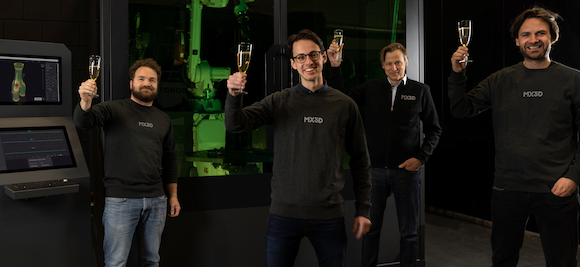Perhaps most known for 3D printing a massive steel bridge in the Netherlands, Dutch startup MX3D has recently received a €2.25 million investment. Funding came from DOEN Participaties, PDENH, and the Netherlands Enterprise Agency (RVO). While MX3D has long been 3D printing some impressive projects, this funding will allow it to launch its robotic metal 3D printing system, the M1, and further drive development of its MetalXL platform.
The M1 is a variation of what we’ve seen MX3D work with up to now in producing such projects as the bridge in Amsterdam, structural steel connectors for Takenaka, the Arc Bike, the Dragon Bench, a spare component for a robotic arm. It is a wire arc additive manufacturing (WAAM) system meant to be a complete metal 3D printing product package, with a welding robot, software and control system.
“This cell contains a smaller robot, an ABB 2600, instead of their big one, the 6700. So, the space needed is more compact,” MX3D CEO Gijs van der Velden told 3DPrint.com. “As most universities and research centers initially focus on medium-size parts, this is big enough and fits in most commercial spaces. This cell is the most popular configuration. But, as we use standard components, we are flexible to offer any type of robot setup with our MetalXL. So, customers can also ask for a big robot without a box for example.”
MetalXL is a software and control system designed to reformat existing welding robots into industrial metal 3D printers. This solution is compatible with a variety of robots, power sources, and sensors. The startup believes that, as progress continues on this product, it would work with over 80 percent of the global robotics market. MX3D claims that it has successfully integrated MetalXL to the operations of a number of launching customers. This investment will allow for a broader commercial release.
“Our Metal XL Software and Control System enables companies to turn their welding robot into a high-end 3D metal printer, in the course of one day,” van der Velden said in a press release. “Since the launch of MetalXL, we have received many customer requests whether we could supply them with a complete solution. The M1 metal AM System is the answer to this call. Now customers without a welding robot can quickly and affordably start printing large metal parts.”
Though it offers much lower resolution than something like powder bed fusion (PBF), WAAM is a less costly way to print metal, given the fact that it can use off-the-shelf materials that don’t’ require the same refined processing as PBF. With MetalXL, this promises to make the technology even cheaper, as existing wire arc machines and, eventually, robotic systems more general can be converted into metal 3D printers.
We also asked MX3D about the status of the bridge project. Van der Velden let us know that the bridge—including its sensor network for measuring strain, displacement, vibration in the bridge, along with capturing environmental data like air quality and temperature—has been finished since October 2018. The quay walls where the bridge will be installed, however, have taken significant time to renovate by the municipality.
“In November 2020 we finally had a permit, we removed the old bridge, and prepared the site. We prepared to load our bridge to the barge to ship to site, but… again there was a setback, as a city inspector thought it was wise to check the quay wall for internal defects, as Amsterdam had some other old quay walls collapse over the last months. Better safe than sorry they thought,” van der Velden said. “Early April, the tests have been completed. We now wait for the green light. So, placement is ongoing, and hopes are high we can pop champagne this summer.”
It will certainly be interesting to see the results of the project as it is installed on-site. It will also be interesting to see just how widespread MX3D’s robots become when they’re installed on existing industrial robots. This is reminiscent of efforts by Optomec and others for increasing the adoption of directed energy deposition (DED) by introducing a method for integrating onto existing CNC machines. If a customer already has most of the equipment, it shouldn’t be too difficult to introduce 3D printing to the equation.
We’ve long seen the potential for industrial robotic arms in 3D printing, with companies like MX3D really being the ones to demonstrate that potential to us. Now, we may see that potential realized. Though there are certainly many kinks to be worked out, one can easily imagine an M1 system fabricating something on a factory floor with additional robotic arms performing other operations, such as finishing that is certainly necessary for the rough layers made by the WAAM process. Now, we just have to see how those kinks will be worked out.
Subscribe to Our Email Newsletter
Stay up-to-date on all the latest news from the 3D printing industry and receive information and offers from third party vendors.
You May Also Like
Further Understanding of 3D Printing Design at ADDITIV Design World
ADDITIV is back once again! This time, the virtual platform for additive manufacturing will be holding the first-ever edition of ADDITIV Design World on May 23rd from 9:00 AM –...
3D Printer Maker EVO-tech Reborn as NEVO3D — Once More With Feeling
EVO-tech was a 3D printing service and original equipment manufacturer established in 2013 and based in Schörfling am Attersee, Austria. The company produced high-quality material extrusion systems featuring linear bearings,...
3D Systems Brings 3D Printed PEEK Cranial Implant to the U.S. with FDA Clearance
For more than 10 years, 3D Systems (NYSE:DDD) has worked hand-in-hand with surgeons to plan over 150,000 patient-specific cases, and develop more than two million instruments and implants from its...
CDFAM Returns to Berlin for Second Annual Symposium
The second CDFAM Computational Design Symposium is scheduled for May 7-8, 2024, in Berlin, and will convene leading experts in computational design across all scales. Building upon the first event...


































